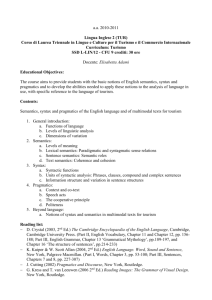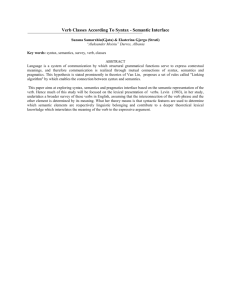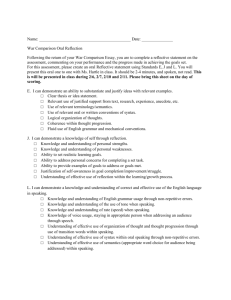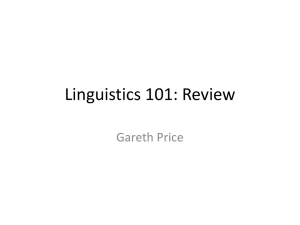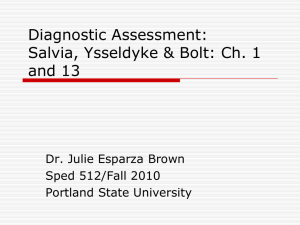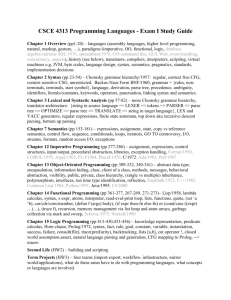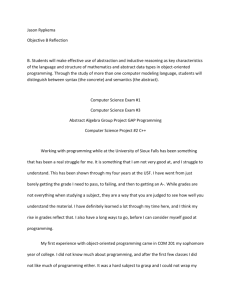Instytutowy Pakiet ECTS 2012/13 - Institute of English, Opole
advertisement
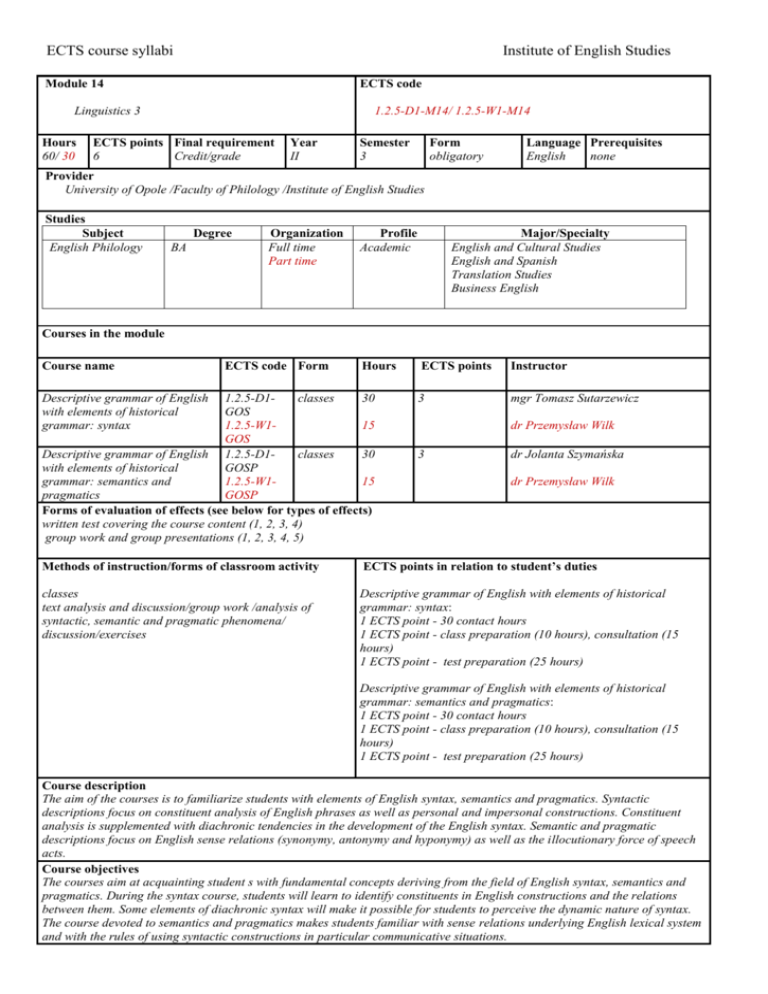
ECTS course syllabi Institute of English Studies Module 14 ECTS code Linguistics 3 Hours 60/ 30 1.2.5-D1-M14/ 1.2.5-W1-M14 ECTS points Final requirement 6 Credit/grade Year II Semester 3 Form obligatory Language Prerequisites English none Provider University of Opole /Faculty of Philology /Institute of English Studies Studies Subject English Philology Degree BA Organization Full time Part time Profile Academic Major/Specialty English and Cultural Studies English and Spanish Translation Studies Business English Courses in the module Course name ECTS code Form Descriptive grammar of English with elements of historical grammar: syntax Hours 1.2.5-D1classes 30 GOS 1.2.5-W115 GOS Descriptive grammar of English 1.2.5-D1classes 30 with elements of historical GOSP grammar: semantics and 1.2.5-W115 pragmatics GOSP Forms of evaluation of effects (see below for types of effects) written test covering the course content (1, 2, 3, 4) group work and group presentations (1, 2, 3, 4, 5) ECTS points Instructor 3 mgr Tomasz Sutarzewicz dr Przemysław Wilk 3 dr Jolanta Szymańska dr Przemysław Wilk Methods of instruction/forms of classroom activity ECTS points in relation to student’s duties classes text analysis and discussion/group work /analysis of syntactic, semantic and pragmatic phenomena/ discussion/exercises Descriptive grammar of English with elements of historical grammar: syntax: 1 ECTS point - 30 contact hours 1 ECTS point - class preparation (10 hours), consultation (15 hours) 1 ECTS point - test preparation (25 hours) Descriptive grammar of English with elements of historical grammar: semantics and pragmatics: 1 ECTS point - 30 contact hours 1 ECTS point - class preparation (10 hours), consultation (15 hours) 1 ECTS point - test preparation (25 hours) Course description The aim of the courses is to familiarize students with elements of English syntax, semantics and pragmatics. Syntactic descriptions focus on constituent analysis of English phrases as well as personal and impersonal constructions. Constituent analysis is supplemented with diachronic tendencies in the development of the English syntax. Semantic and pragmatic descriptions focus on English sense relations (synonymy, antonymy and hyponymy) as well as the illocutionary force of speech acts. Course objectives The courses aim at acquainting student s with fundamental concepts deriving from the field of English syntax, semantics and pragmatics. During the syntax course, students will learn to identify constituents in English constructions and the relations between them. Some elements of diachronic syntax will make it possible for students to perceive the dynamic nature of syntax. The course devoted to semantics and pragmatics makes students familiar with sense relations underlying English lexical system and with the rules of using syntactic constructions in particular communicative situations. Course content Descriptive grammar of English with elements of historical grammar: syntax: 1. Constituent and constituent structure 2. Phrase and its types 3. Syntactic categories 4. The structure of English verb phrase 5. The structure of English noun phrase 6. Modification 7. Complement clauses 8. Adverbial clauses 9. Impersonal constructions 10. The development of English syntax in a diachronic prespective Descriptive grammar of English with elements of historical grammar: semantics and pragmatics: 1. Meaning: lexical and grammatical meaning 2. Meaning vs. sense 3. Denotation vs. connotation 4. Sense relations (antonymy, symonymy, hyponymy) 5. The relationship between meaning and linguistic form (polyesmy, homonymy) 6. Illocutionart act, illocutionary force 7. The relationship between illocutionary force and sentence structure 8. Direct and indirect speech acts Reading list A. obligatory reading (to get a credit): A.1. used in class Burton-Roberts, N. (2011). Analysing sentences: An introduction to English syntax (3rd ed.). Pearson: Harlow. Lyons, J. (1977). Semantics 1. Cambridge: Cambridge University Press. Lyons, J. (1977). Semantics 2. Cambridge: Cambridge University Press. A.2. used for self-study Radford, A. (2009). An introduction to English sentence structure. Cambridge: Cambridge University Press. B. supplementary reading Carnie, A. (2007). Syntax: A generative introduction. Blackwell Publishing: Malden. Culicover, P. W. (2009). Natural language syntax. Oxford: Oxford University Press. Lyons. J. (1981). Language and linguistics. Cambridge: Cambridge University Press. Effects Knowledge Student: 1. is familiar with fundamental terminology relevant to English syntax, semantics and pragmatics (K_W04) 2. has the basic knowledge pertaining to the essence and importance of research in syntax, semantics and pragmatics (K_W07) Skills Student: 3. is able to apply basic theoretical approaches and terminology relevant to English syntax, semantics and pragmatics (K_U04, K_U05) 4. has the relevant language competence to use and understand professional discourse of researchers working in the field of syntax, semantics and pragmatics (K_U09, K_U13, K_U14) Social competences Student: 5. can cooperate and work in a group, assuming different roles (K_K04, K_K05, K_K06) Contact dr hab. J. Malak: magoret@poczta.onet.pl dr J. Szamańska: szymanska.jolanta@interia.pl dr Przemysław Wilk: przemekwilk82@gmail.com
